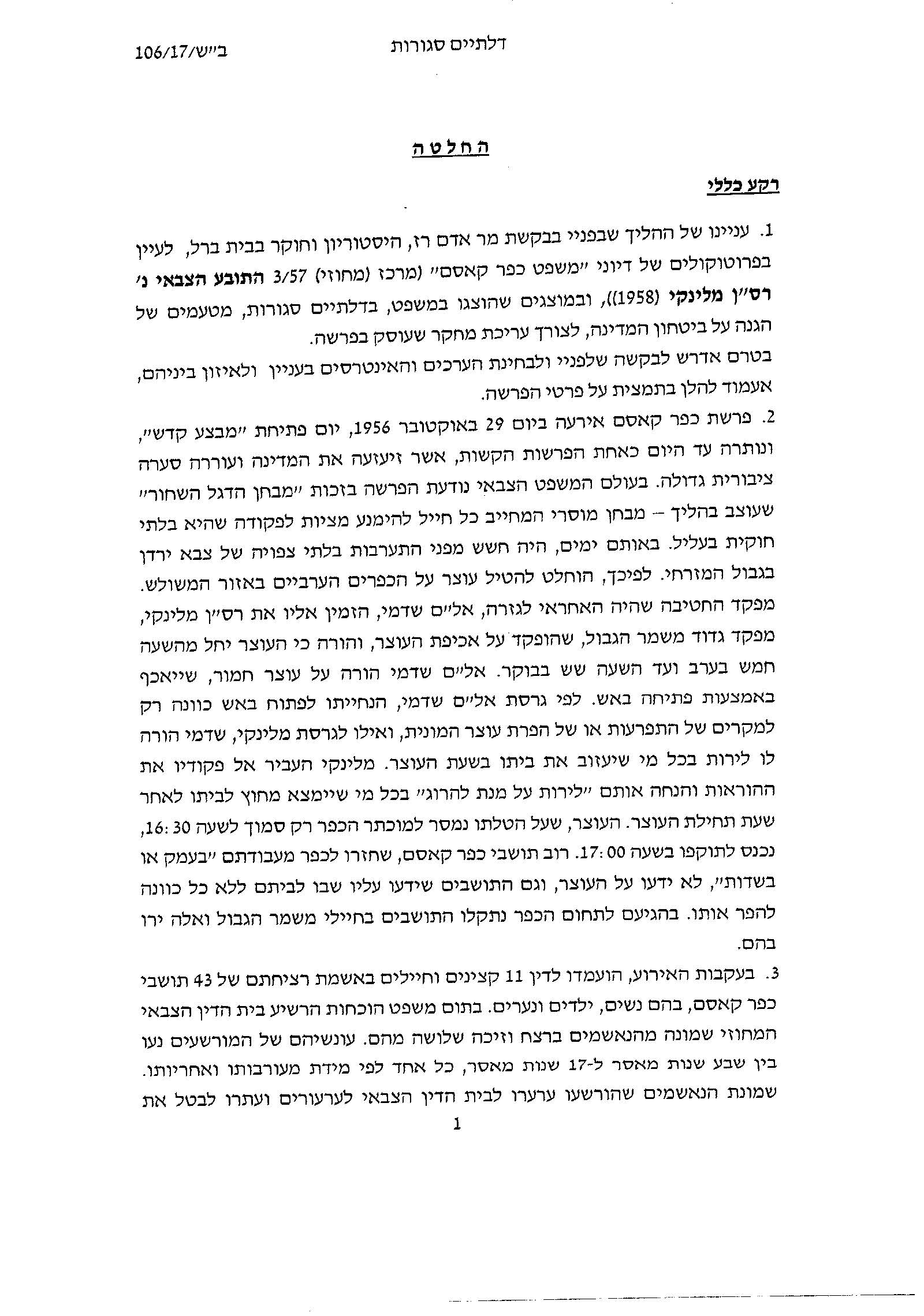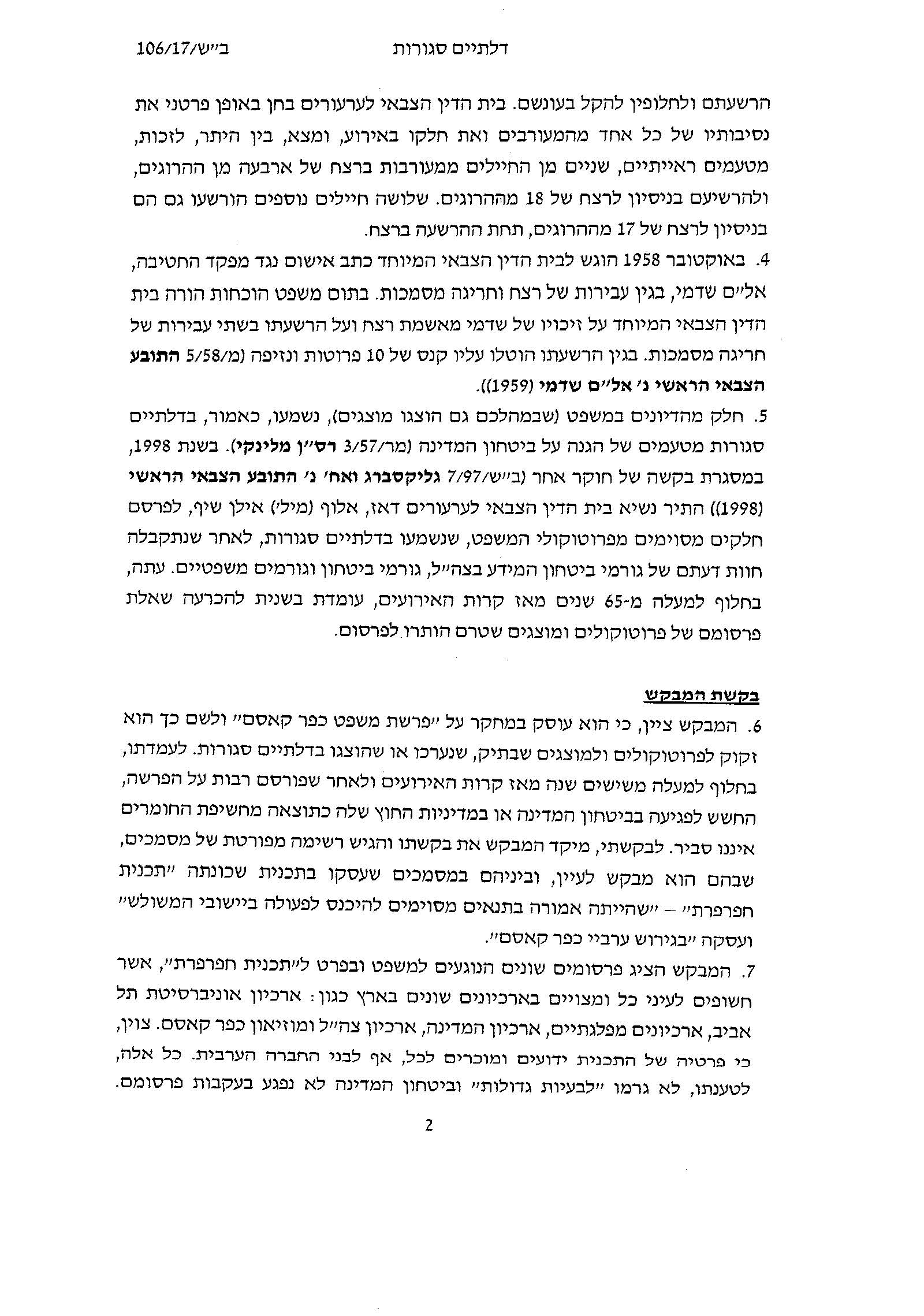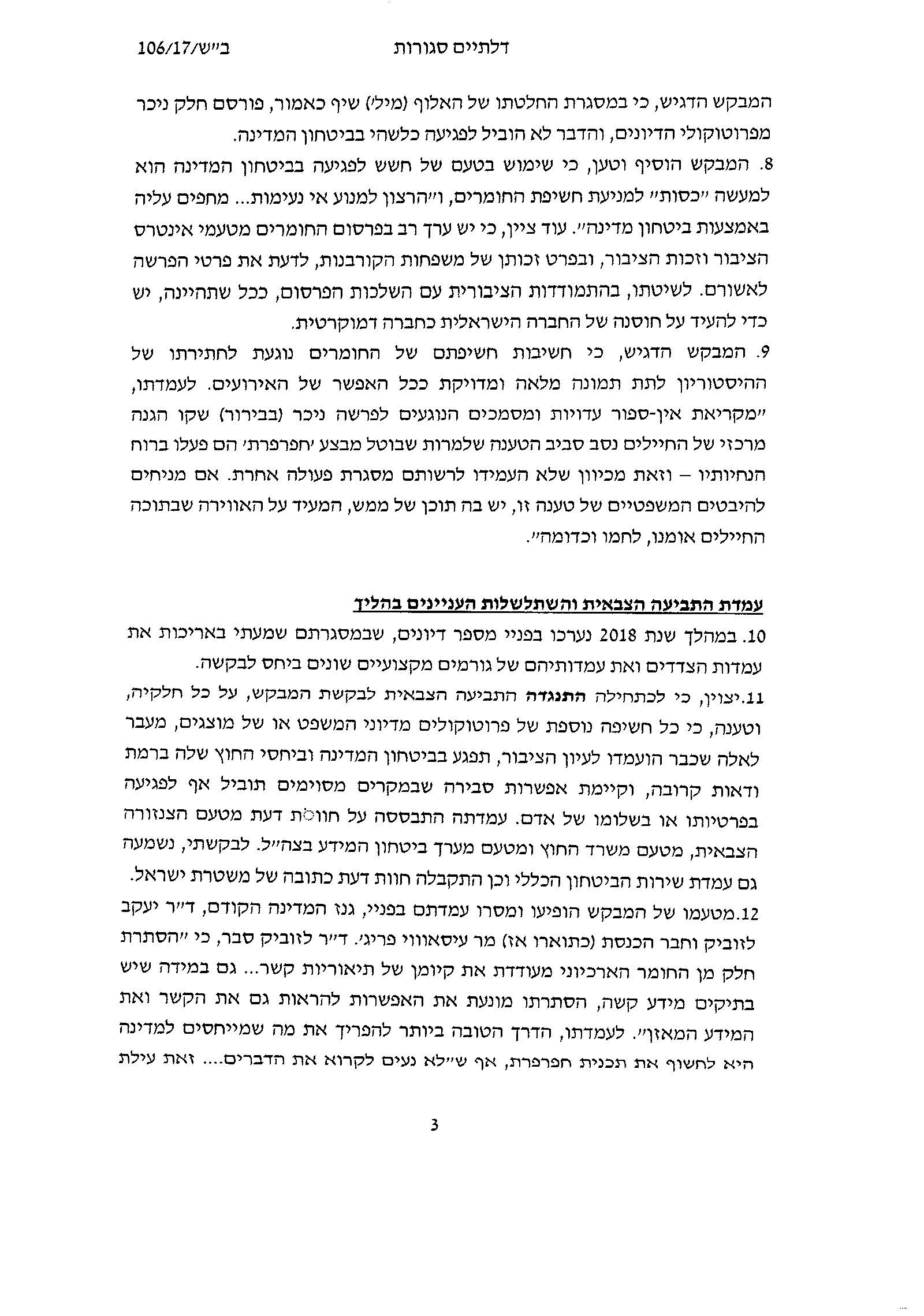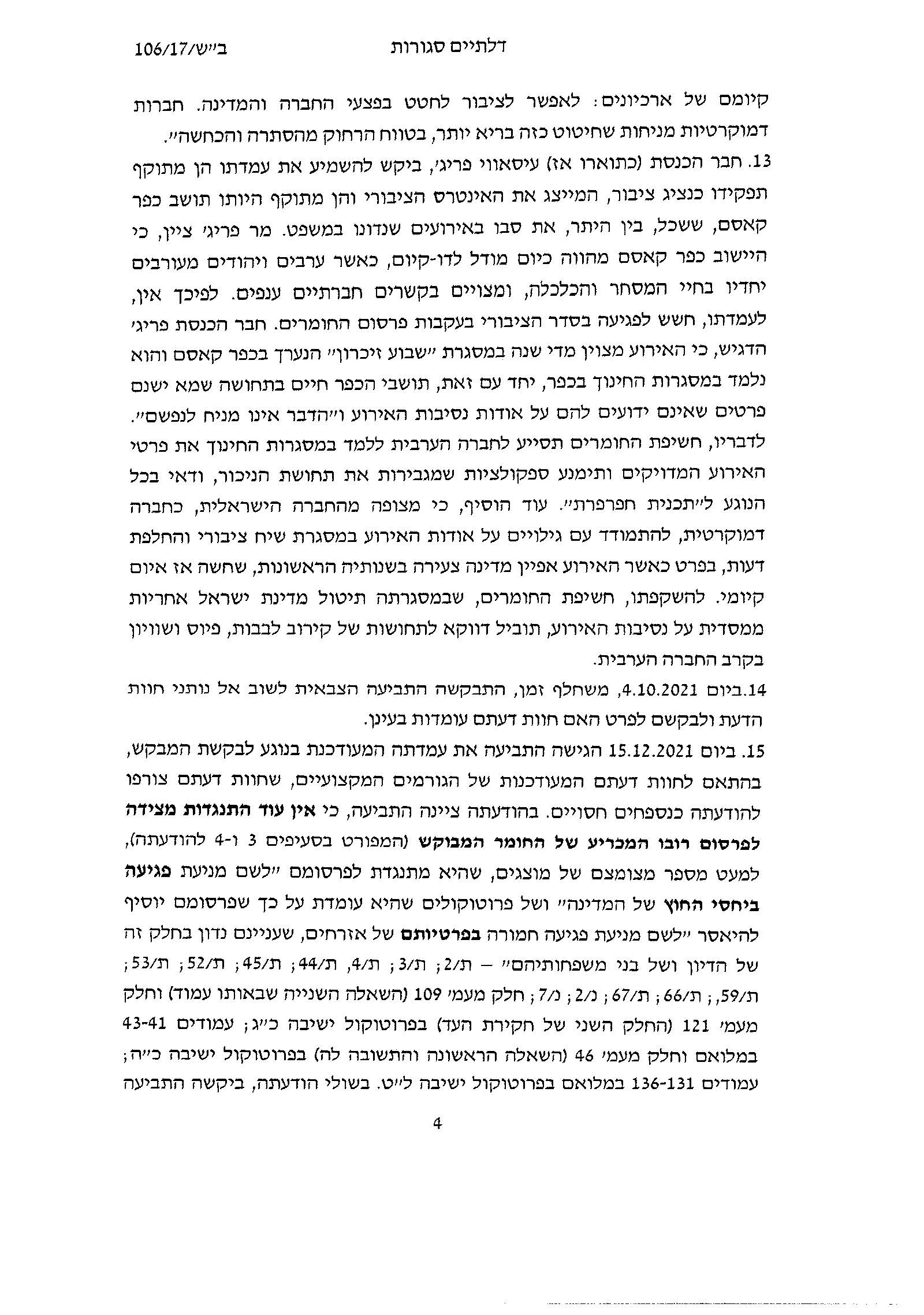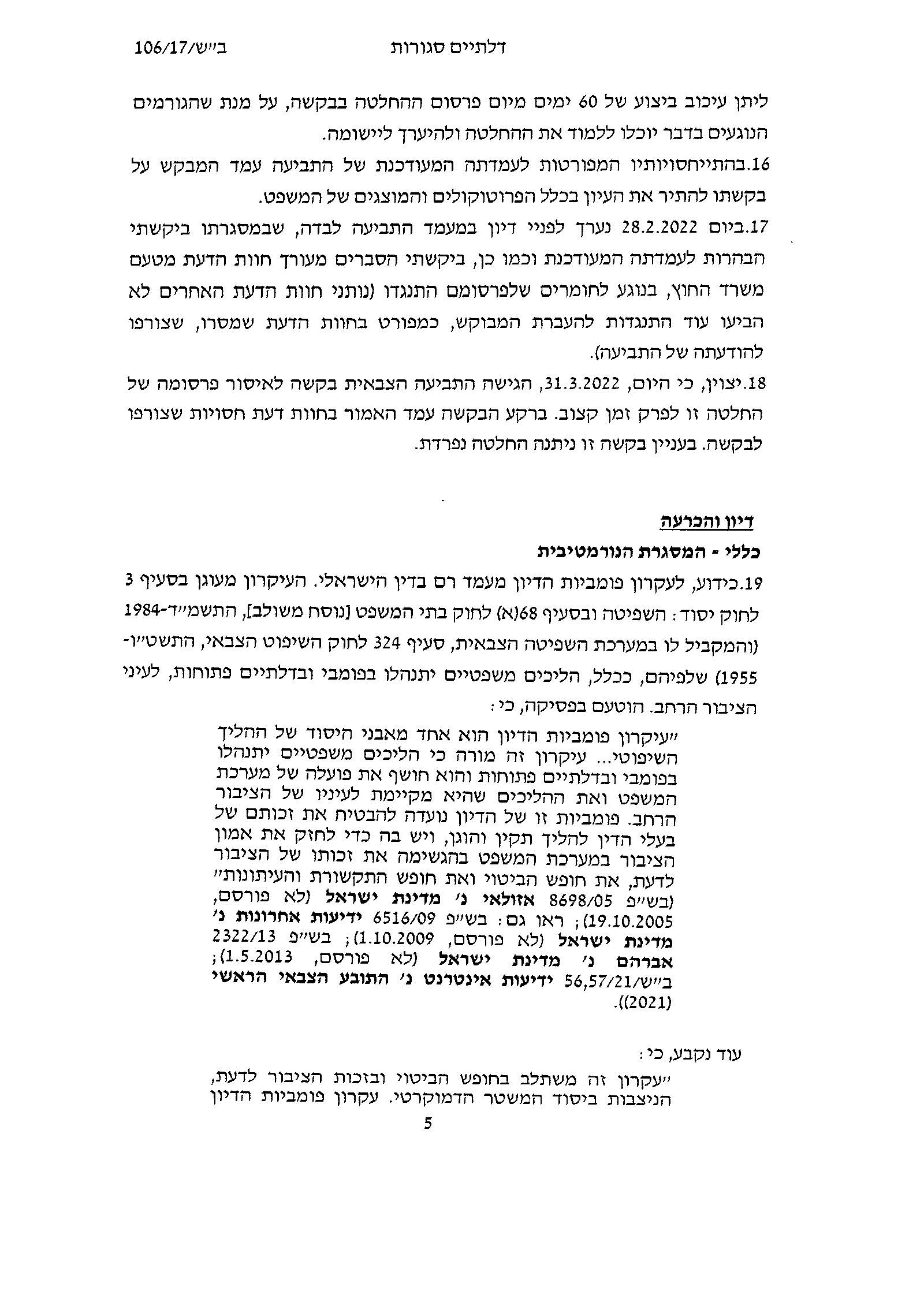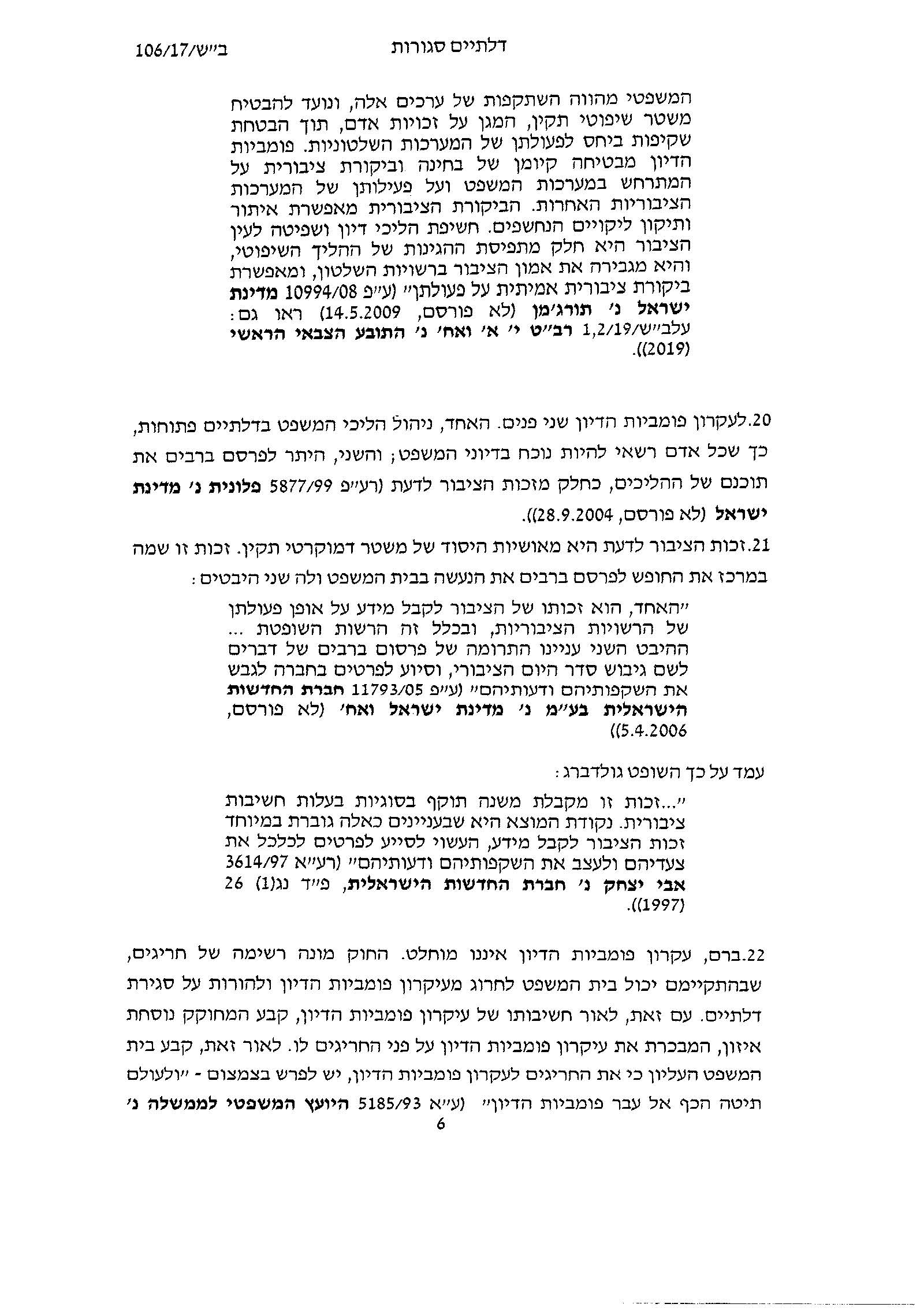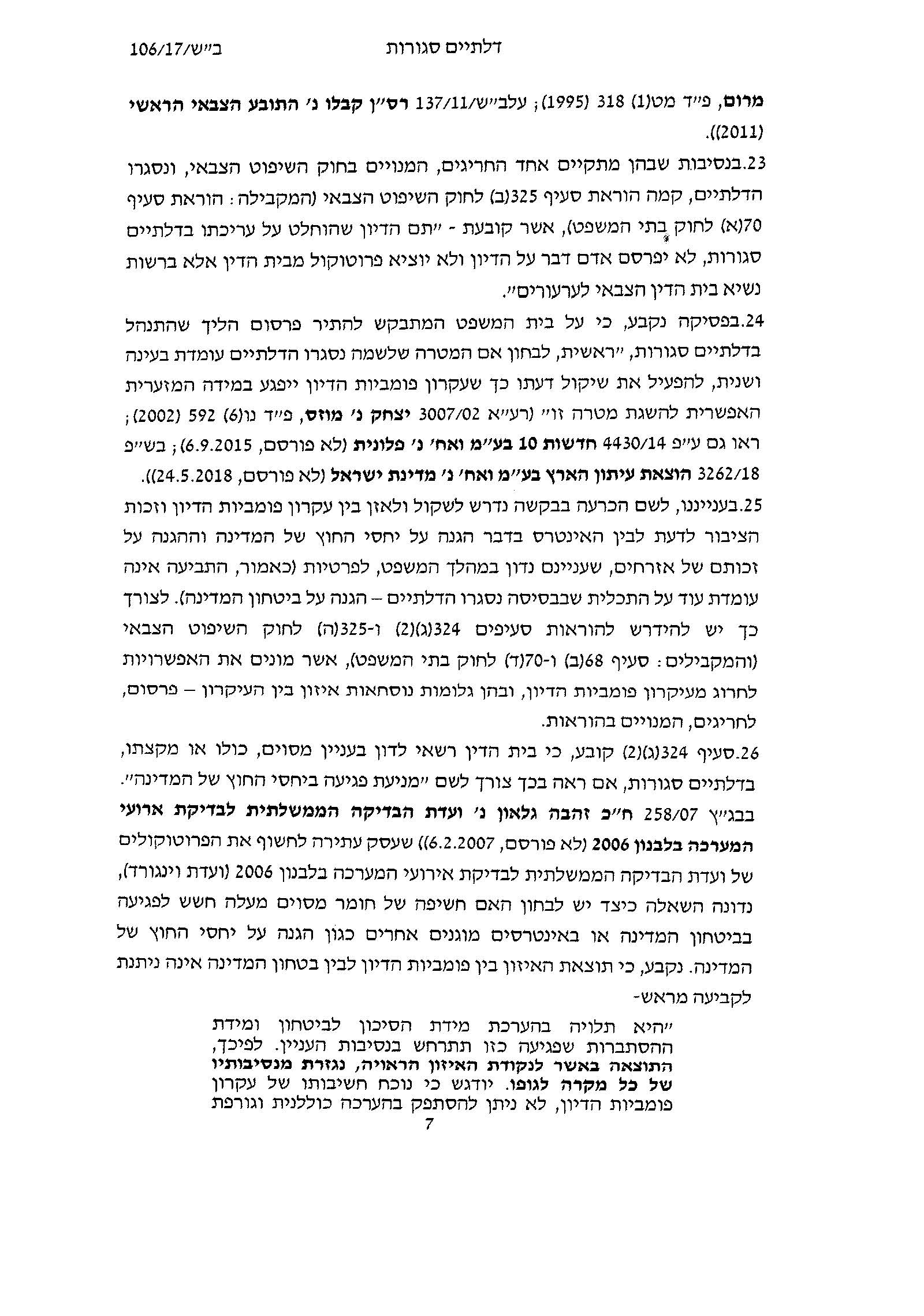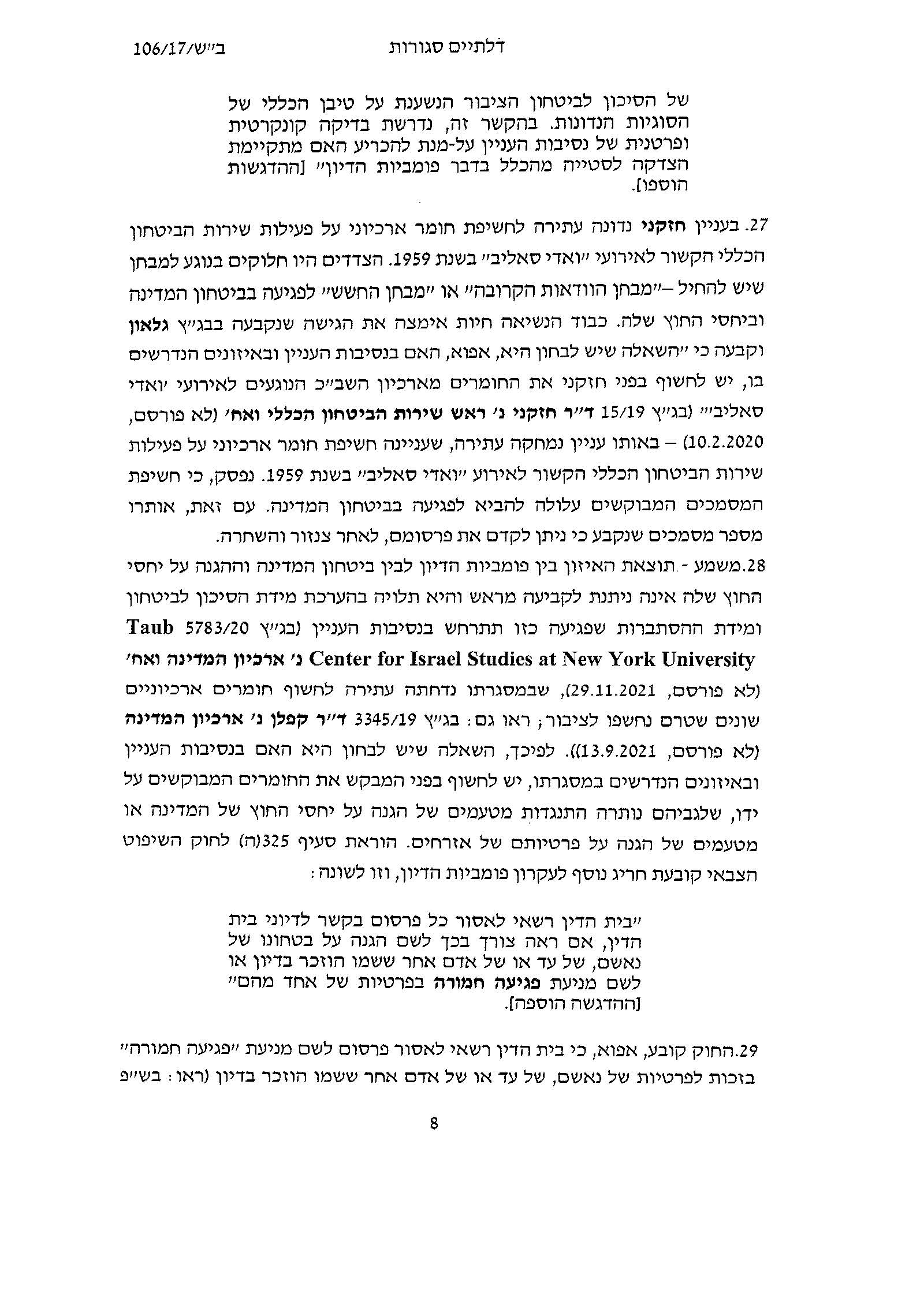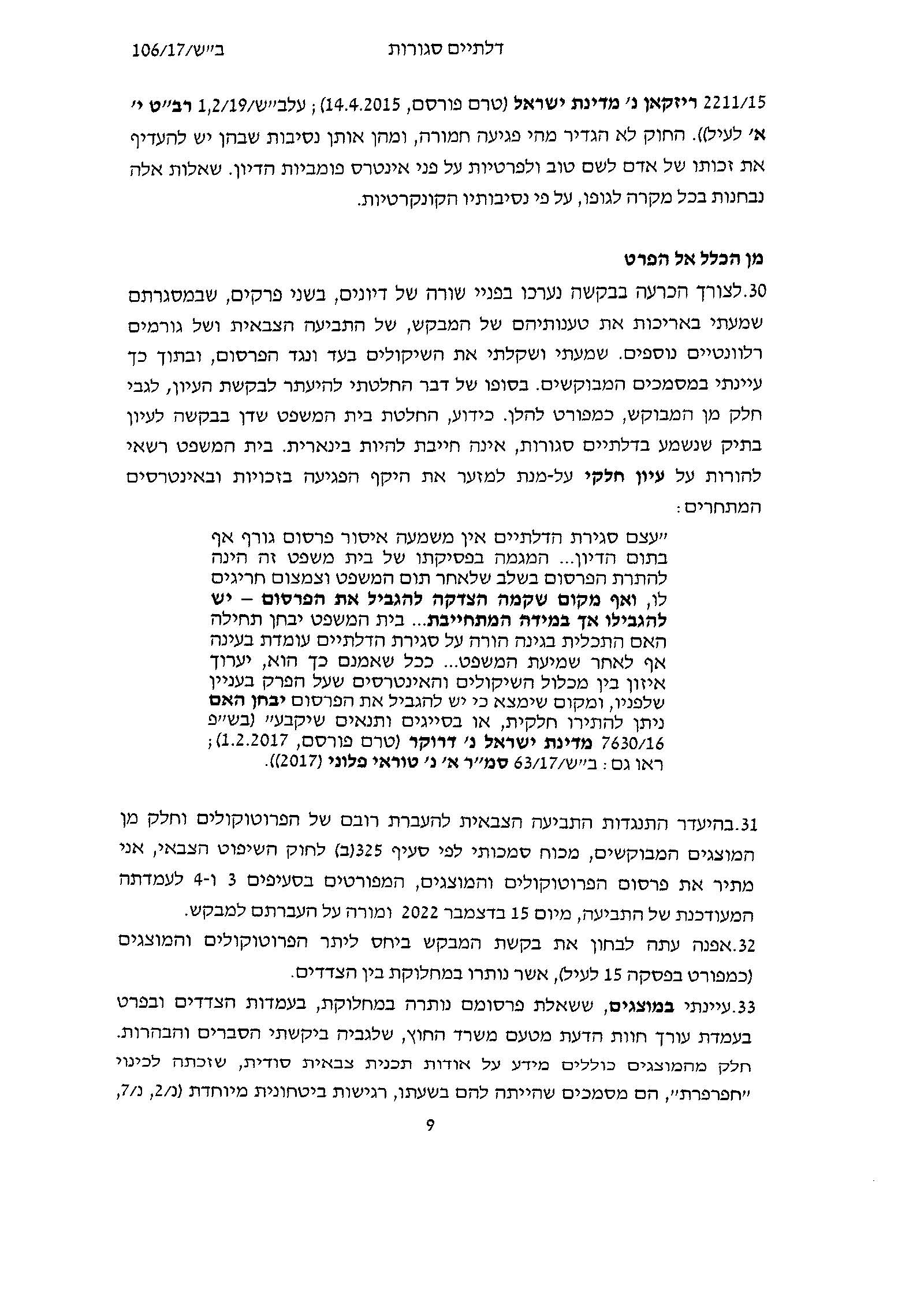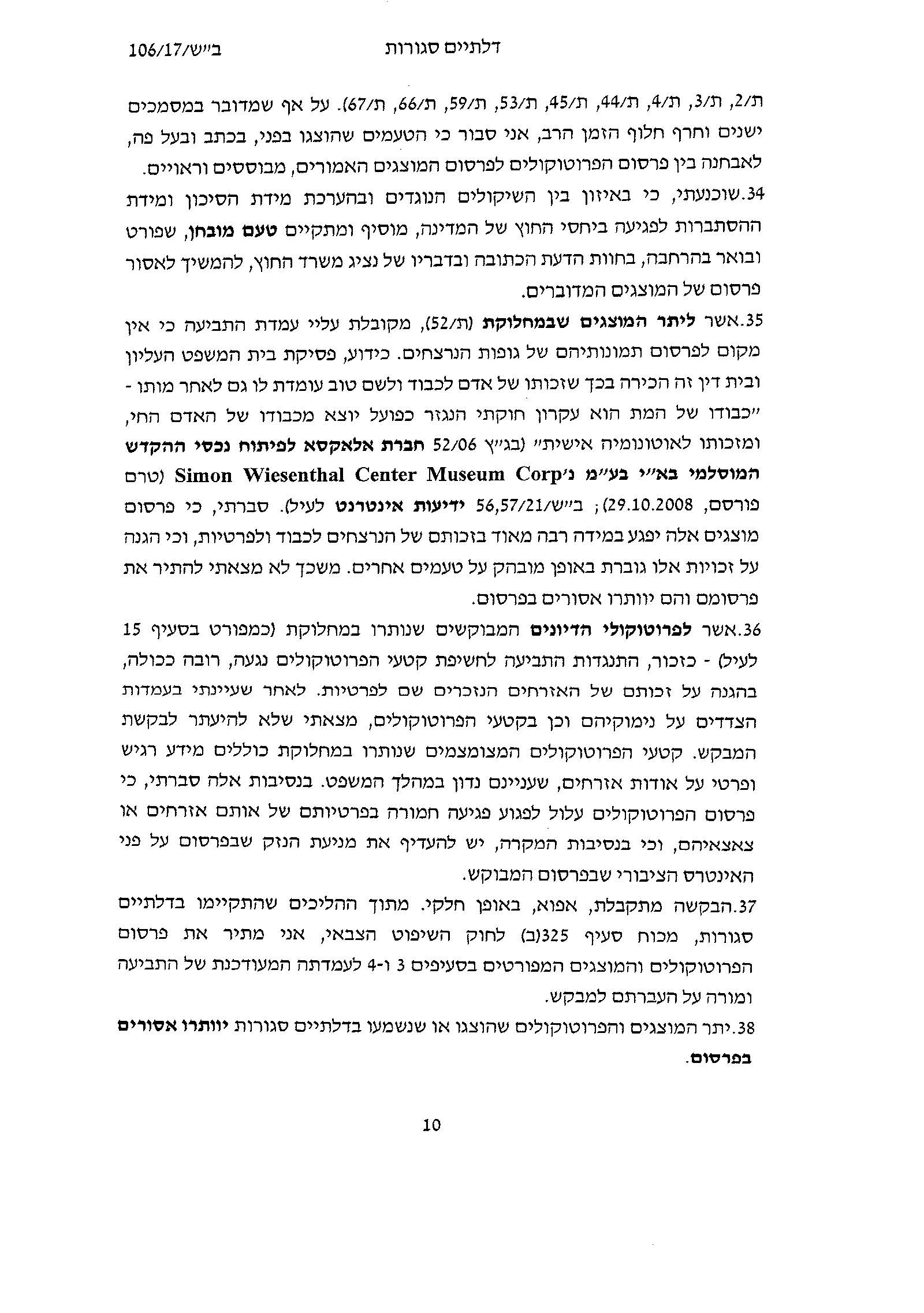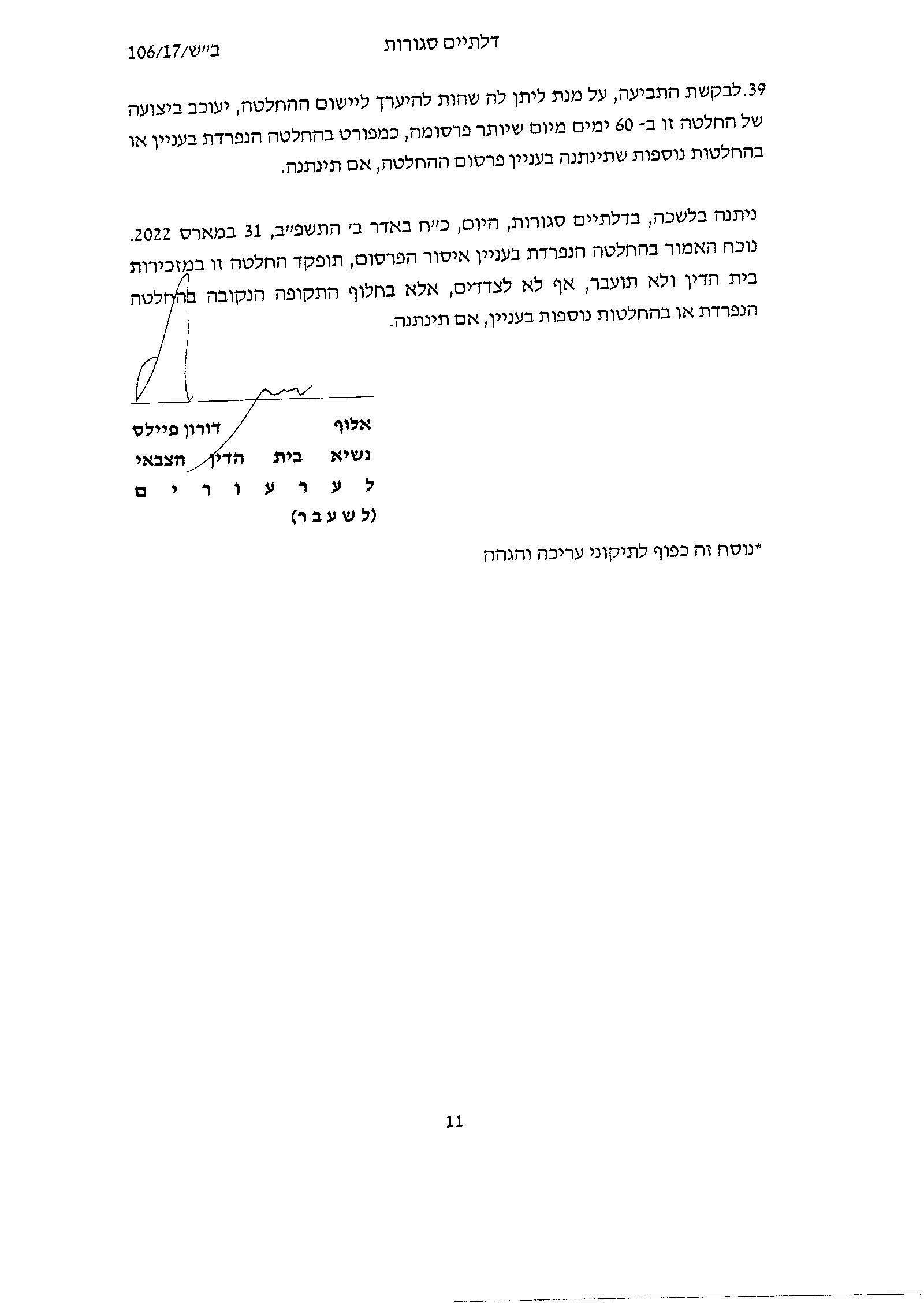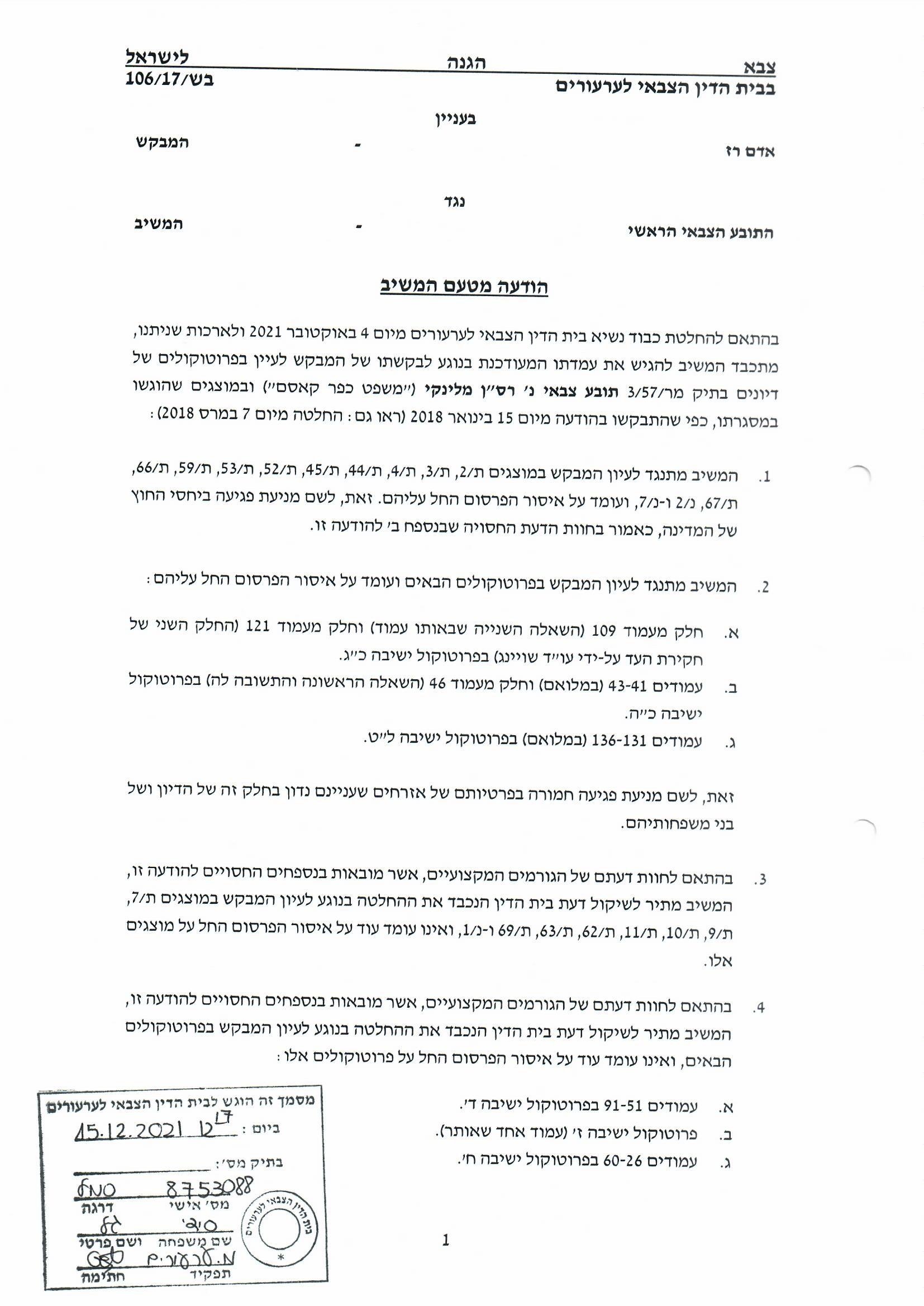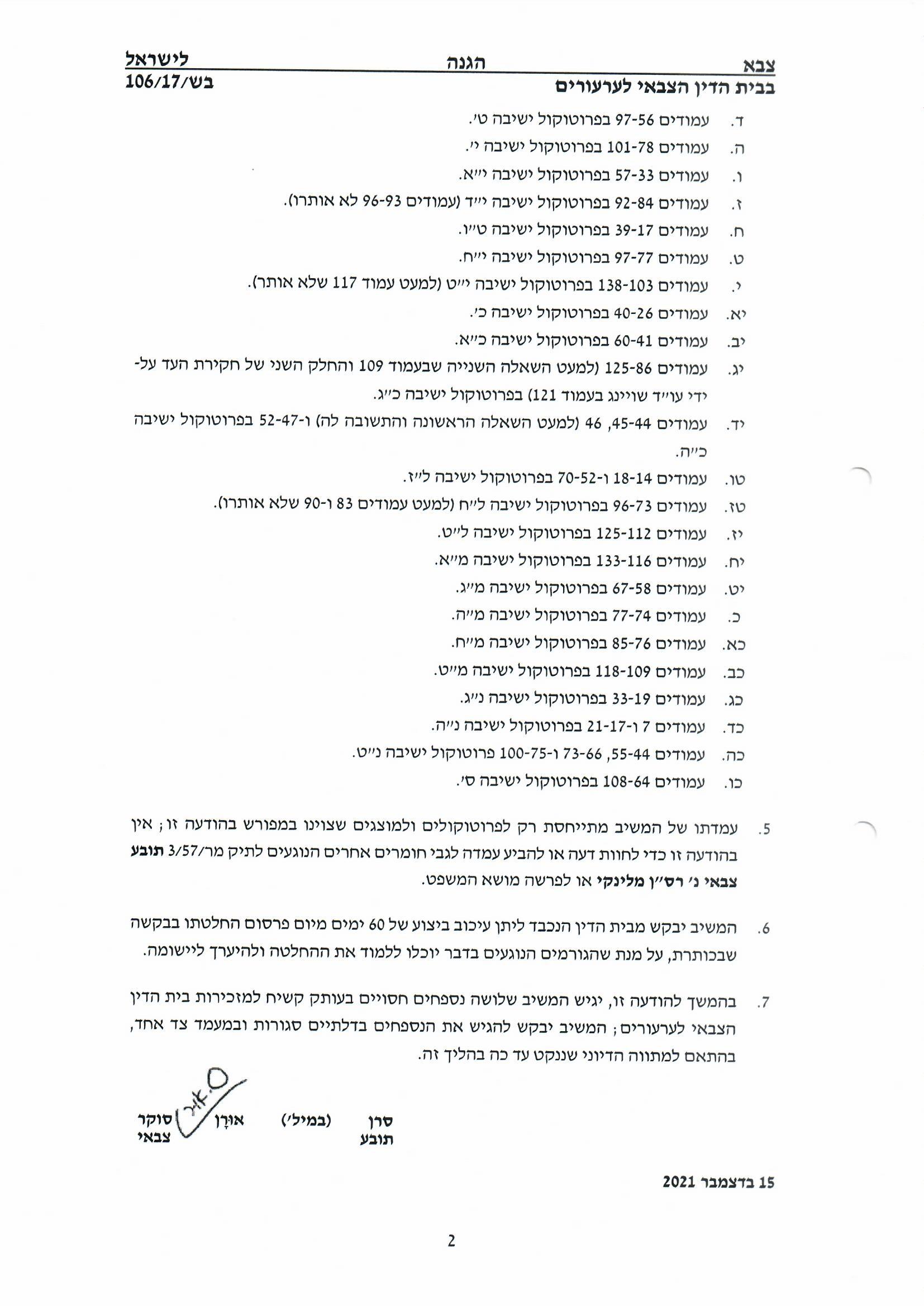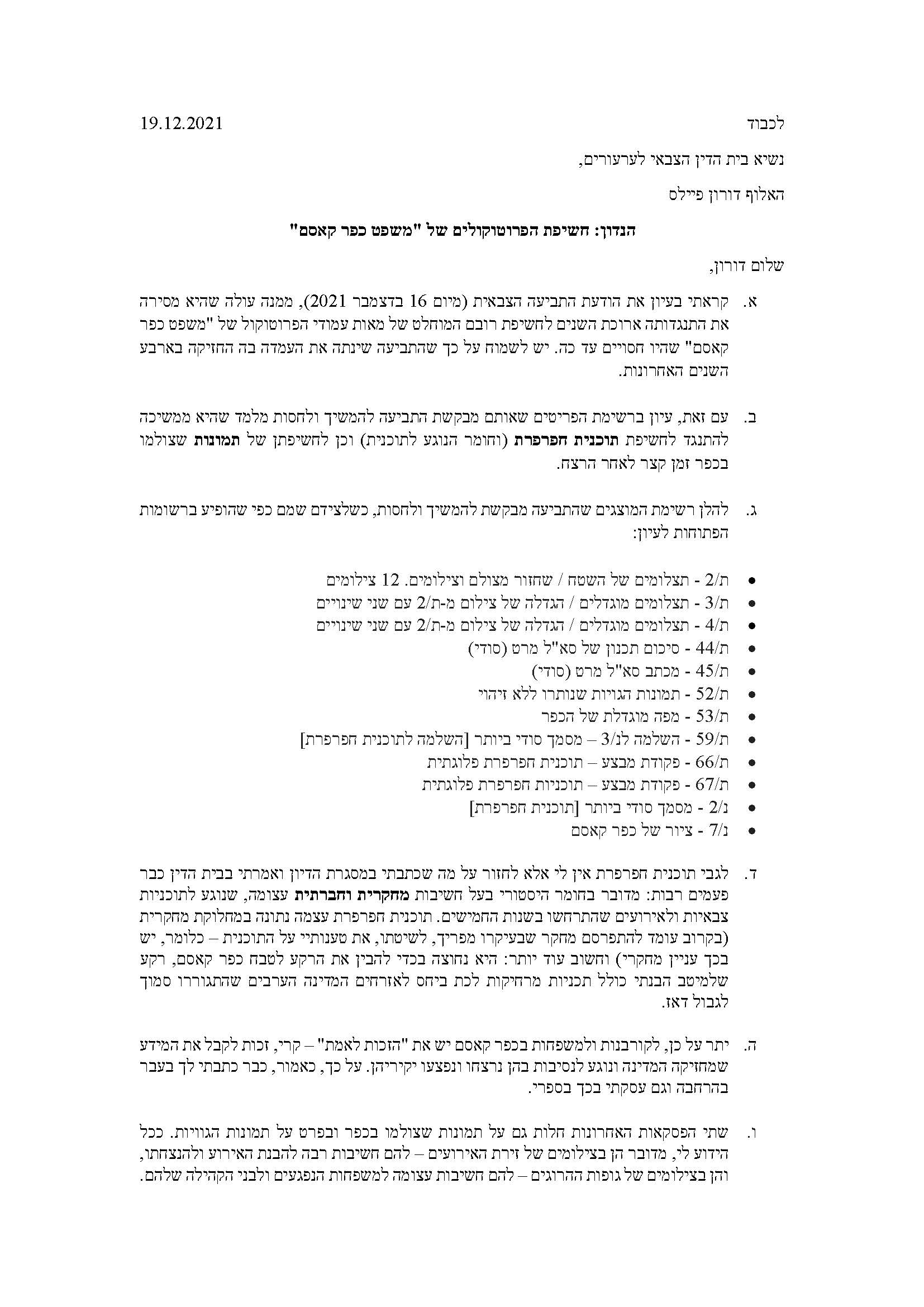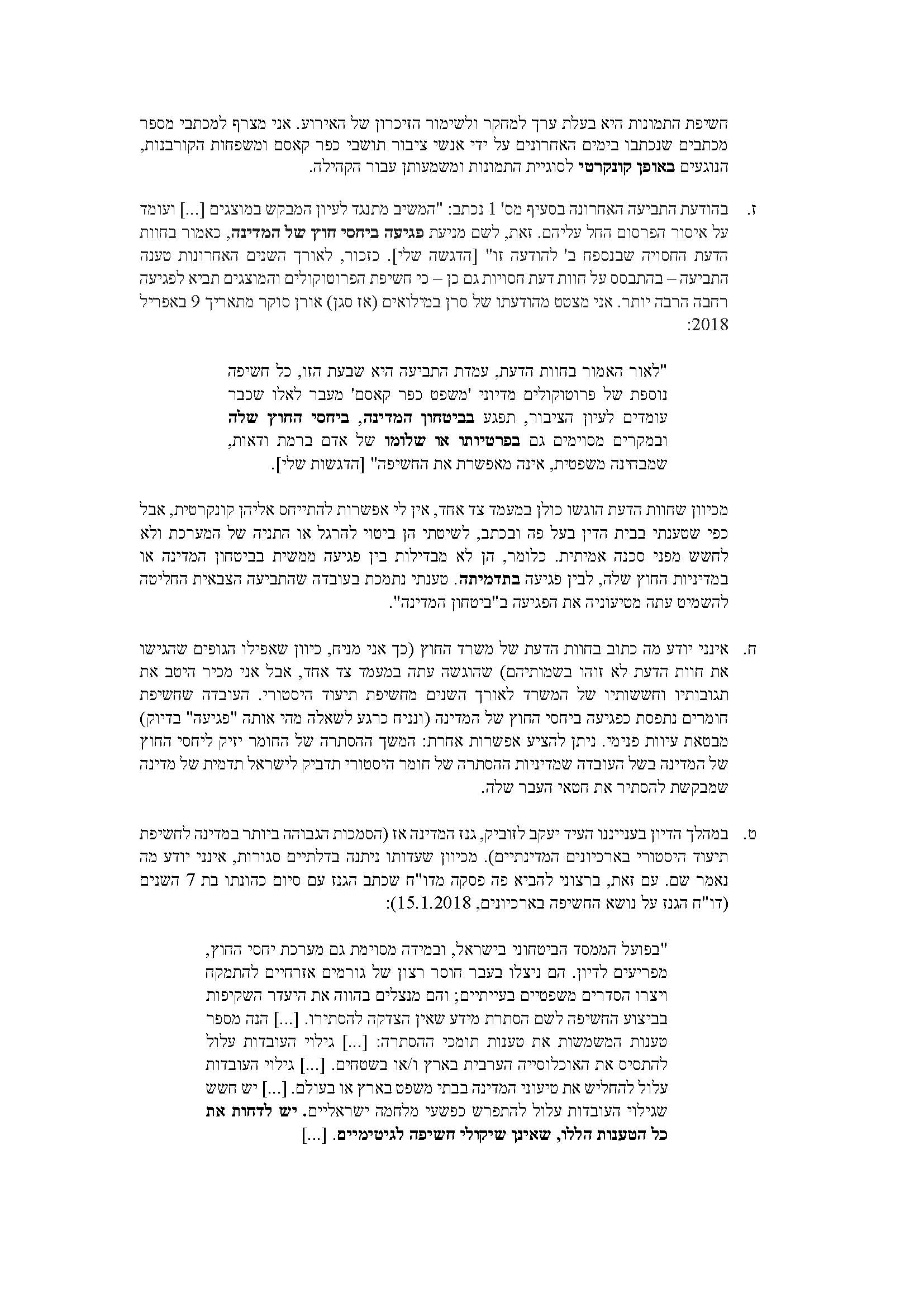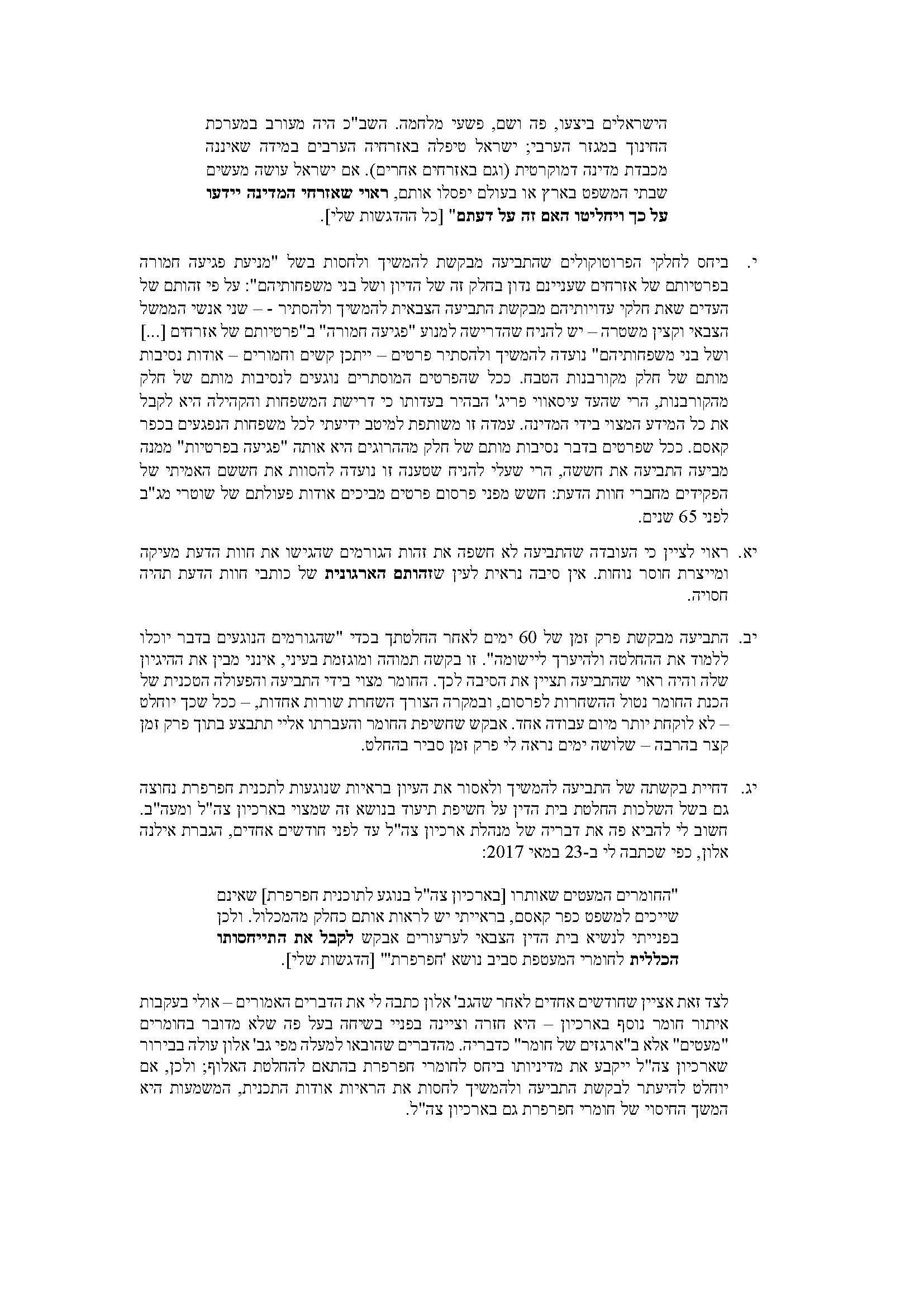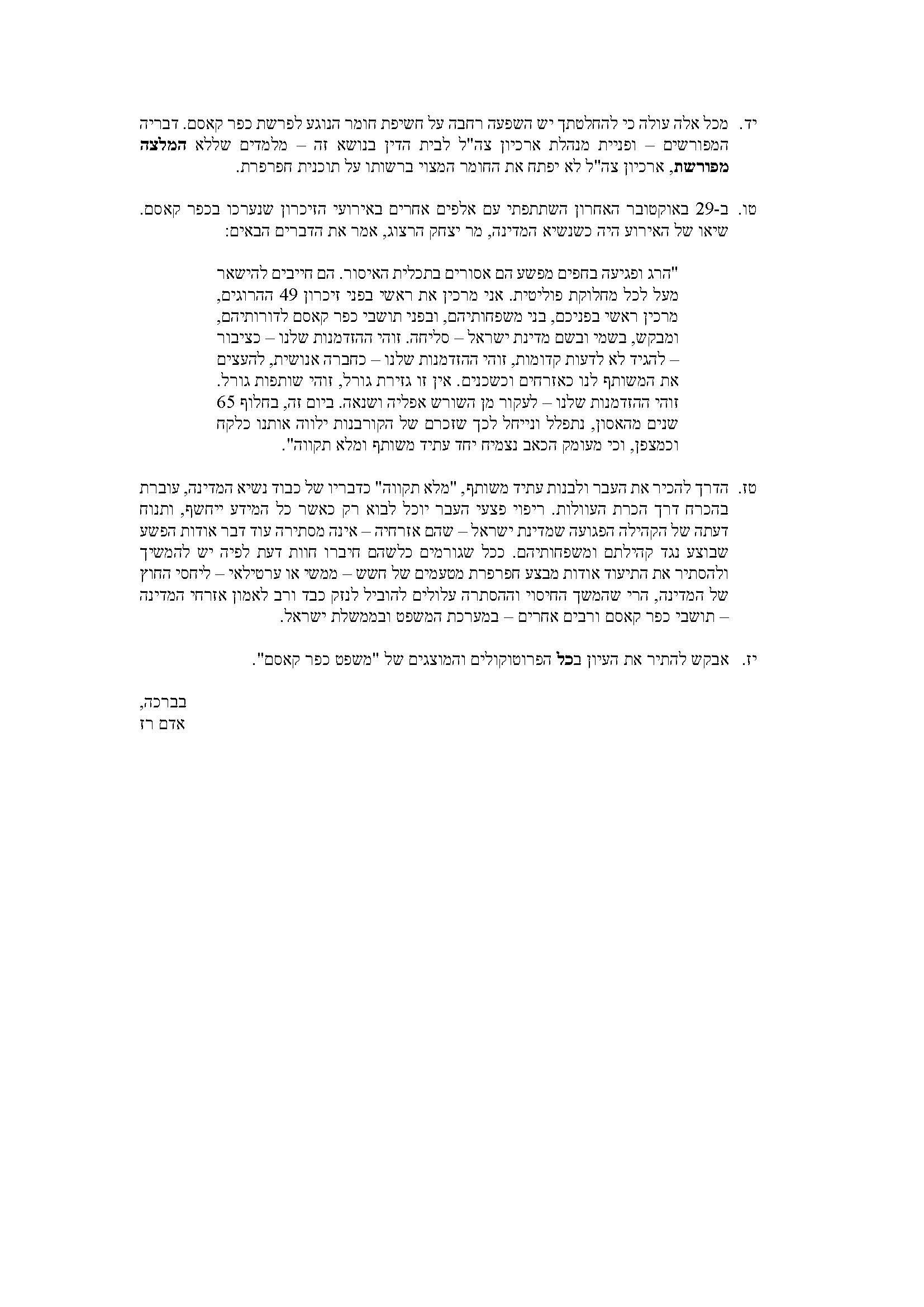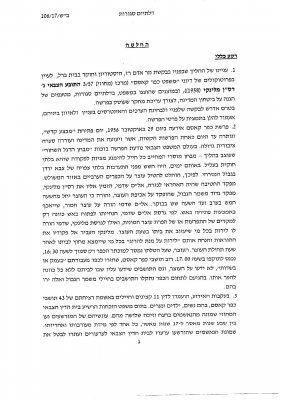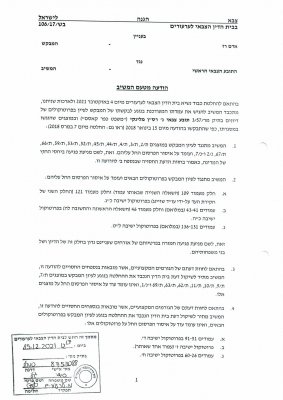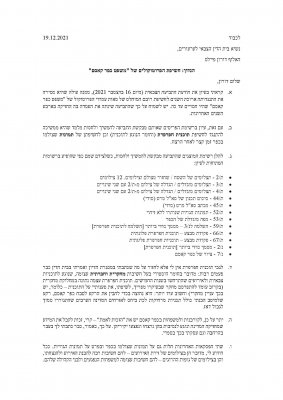Following a review of records from the Kafr Qasim Massacre trial opened for public access by order of the Military Court in an application brought by an Akevot Institute researcher, Akevot Institute presents a summary of Plan Mole’s key points. Now, with the plan’s details clearly emerging from the opened records, it is difficult to find justification for keeping the remaining records sealed.
A. BACKGROUND
In August 2022, the Military Court of Appeals ruled in an application made by Akevot Institute researcher Adam Raz, ordering the release of new materials from the Kafr Qasim Massacre trial held in 1957.
The trial transcripts consisted of around 8,000 pages, mostly pertaining to the open court hearings, which were covered extensively by the press at the time. Several hundred pages of transcripts contained what was said in closed-door hearings and, therefore, remained sealed for decades. In 1998, following a request brought to the Military Court of Appeals by residents of Kafr Qasim and Naftaly Gliksberg, a journalist and filmmaker, the president of the Military Court at the time granted access to a small portion of the records. However, records pertaining to Plan Mole remained sealed. The vast majority of the historical records now cleared for access relates to this plan.
For several years after Raz submitted the application to open the records in 2017, the state, represented by the Military Prosecution, maintained the position that none of the remaining sealed transcripts or exhibits from the Kafr Qasim Massacre trial whatsoever should be opened for public access. The position was based on secret expert opinions submitted to the Military Court by various parties. It was only in late 2021 that some of the parties changed their position regarding a large part of the requested records, and several months later, the former president of the Military Court of Appeals, Major General Doron Feiles, issued his decision.
In practice, most of the transcripts have been opened for access, while some of the key exhibits – including a concise version of Plan Mole and several military documents relating to it – remain sealed on the grounds of protecting Israel’s foreign relations. The court also withheld permission to access photographs taken at the scene about three months after the Massacre, as well as photos of some of the victims themselves. Akevot Institute continues the legal battle to have the sealed records opened.
The transcripts that have been released for public access contain the closed-door testimonies of various figures involved in the affair – from GOC Central Command Major General Zvi Tzur to the commander of the 17th Brigade, Lt. Col. Issachar (Yiska) Shadmi and the military governor of the Center (Triangle) Area, Zalman Mart, all the way to the commanding officers and soldiers who were directly involved in the incident. Though Plan Mole, a brief summary of which was submitted to the court as Exhibit D/2, remains sealed, references the witnesses made to the plan itself and to other sealed derivative documents allow us to delineate its general contours with a great deal of precision. Over the coming weeks, Akevot Institute will upload all the records pertaining to Plan Mole to a special online library, providing free access to the documents.
***
The recently released records indicate Plan Mole was intended for the displacement of Arab communities in frontier areas in the event of war (this is how 17th Brigade Commander Col. Issachar Shadmi described the plan in a statement to the Military Police immediately after the Massacre – Exhibit D/1). Testimonies given by various witnesses during closed-door hearings held by the Military Court sketch out the four main elements of plan: curfew, arrests (of individuals “marked” in advance, as well as mass arrests of entire age groups), confiscation of means of subsistence in Arab villages in frontier areas, and the transfer of the entire population of these villages to other localities in the country’s interior. The written version of Plan Mole contained no instructions on expulsions to Jordan. However, closed-door testimonies (as well as a later account by Avraham (Abrasha) Tamir, who was involved in drafting the plan) indicate that both the authors of the plan and the Border Police officers on the ground understood that the Oral Law behind the plan’s draconian measures was to encourage residents of the Triangle to flee across the border, into Jordan. The plan did not include instructions on the open-fire policy.
The plan – which was classified as secret – was given to the commander of the 2nd Battalion of the Border Police, Shmuel Malinki, in a meeting with GOC Central Command Zvi Tzur on October 24, five days before the Massacre, and he was tasked with operationalizing it. Malinki met with the military governor of the Triangle area, Zalman Mart, to discuss the matter and then convened his subordinate officers, the company and platoon commanders, and informed them of the overall plan and its various components. They then went on a reconnaissance patrol in the field. The lower ranks, squad commanders and Border Police officers who were deployed on the ground, likely did not see the written plan, but their testimonies reveal they, too, were aware of its existence and had been briefed on it.
On the night of October 28, 1956, hours before the Massacre, Battalion Commander Malinki was informed that the plan had not been approved in its entirety. However, on Monday afternoon, October 29, the Border Police battalion under Malinki’s command was tasked with implementing part of it, namely imposing a curfew on the villages in the southern Triangle by sectors as established in the briefing given ahead of the expected implementation of Plan Mole. Malinki briefed his subordinate company commanders accordingly, and they set out to the villages to carry out the missions. In parallel, another element of the plan was carried out: arrests by the Israel Police of individuals identified in advance in a document known as “List A”, based on a list prepared by the Shin Bet.
The recently unsealed portions of the transcripts from the trial of the 11 Border Police officers prosecuted in 1957-8 indicate the lawyers were extremely cautious not to go into the details of Plan Mole during examinations due to its secrecy. For example, after witness Haim Levy of Company C of the 2nd Border Police Battalion listed the plan’s key points, Adv. Asher Levitsky, counsel for one of the defendants, warned him: “We are not interested in too much detail” [Session 19, pp. 105-106]. Nonetheless, the newly revealed testimonies make it possible to delineate the plan’s general outline with clarity: both the means listed in it explicitly and its underlying aims.
B. ELEMENTS OF PLAN MOLE
1. Curfew
The first element of Plan Mole was a curfew on Palestinian villages. According to the plan, the curfew would be imposed on all villages in the sector simultaneously, while the remaining elements of the plan would be implemented gradually, one village at a time, due to personnel limitations.
Company Commander Haim Levy testified: “Mole stated that the order would be carried out in full in one village,” and “a relatively small force would patrol the rest of the villages at the same time only to observe the curfew without setting up observation posts, roadblocks, or a mobile force to patrol. At the same time, the main force will carry out the order in full in one of the villages.” [Session 20, May 7, 1957, pp. 33-35]
2. Arrests
The second element of Plan Mole was arrests of Palestinian villagers. This included both the arrest of individuals named in a list prepared ahead of time and mass arrests of certain demographics.
(a) “List A”: Arrests of targeted individuals
Plan Mole included an order to arrest anyone considered a “dangerous element.” For this purpose, the Military Rule headquarters prepared a list known as “List A,” which contained the names of Triangle residents marked as a threat to national security. In court, the military governor of the Triangle area, Zalman Mart, described the attributes of those included in List A:
The Center Military Rule headquarters has a list of Triangle residents, List A, which includes individuals who, in some circumstances, pose a primary threat to national security[.] These are the people who habitually cross the border back and forth and maintain constant contact with the enemy[,] for the most part, smugglers.
[Session 23, May 13, 1957, p. 121]
Zalman Mart’s testimony indicates that the list was compiled by officials from all security agencies in the field: the Military Rule, military intelligence, the police and the Shin Bet. “List A is rather long,” Mart said in court, “but all in all, ten orders for Triangle residents were signed, and as far as I can recall, a total of six, maybe ten, were arrested” [Session 21, May 8, 1957, p. 57). Mart said the list of individuals to arrest on October 29, 1956, which was extracted from List A, was compiled by the Shin Bet. None of the individuals listed was a resident of Kafr Qasim.
(b) Mass arrests
In addition to arrests of smugglers identified ahead of time, Plann Mole included a directive to perform mass arrests. As to the scope of these mass arrests – accounts differed. Shortly after the Massacre, on November 1, 1956, Battalion Commander Shmuel Malinki told the investigating officer that Plan Mole included, among other things, the “imprisonment of hostile elements and Arab youths of conscription age” (Exhibit P/7). According to the testimony of Sergeant Binyamin Kol, a platoon commander in Company C, the plan included an order to move all the men into enclosures. “There was a written order,” Kol told the court, “among other things, it mentioned the enclosures.” In the same session, Kol also said: “This order explained that all the men must be put in the enclosures” [Session 49, July 8, 1957, pp. 112, 116].
Yeshayahu Leizerovic, the commander of Company E, who was stationed in the village of Taybeh, saw the order Company Commander Yehuda Frankental prepared for his company and was briefed according to it (Exhibit P/66). Leizerovic testified that the plan included the construction of enclosures for all village residents. When examined by Adv. Yitzhak Oren, the platoon commander was asked: “You told my colleague that according to ‘Mole,’ certain people should have been imprisoned in enclosures. Who should have been imprisoned?” To this, Leizerovic replied: “It mentioned that the whole village should have been used as an enclosure, but there was no mention of those who would flee to the east. Obviously, we were to jail the ones who stayed” [Session 53, July 15, 1957, p. 31].
3. Confiscation of means of subsistence
The third element of Plan Mole was the destruction of the economic infrastructure in Triangle villages where the plan was to be implemented. This was to be achieved by confiscating all vehicles in the villages (Binyamin Kol’s testimony in Session 49, July 8, 1957, p. 112), as well as any working animals found in them (Shmuel Malinki’s testimony in Session 48, July 4, 1957, p. 78). According to the testimony of Company Commander Haim Levy, the forces had lists that included “a breakdown of how many there are, where they are, and who has them” (Session 19, May 2, 1957, pp. 103-105). Company E Commander Yehuda Frankental said this element of Plan Mole was intended to “break their [Triangle villages] economic backbone” (Session 18, May 1, 1957, p. 87).
4. Displacement and relocation of villages to other localities
The core of Plan Mole centered on depopulating Palestinian villages located close to the borders of the day and relocating their residents to “the country’s interior,” meaning other Arab villages located farther from the border. Presiding Judge Advocate Binyamin Halevi summed up Plan Mole as follows: “Mole is different [from a curfew]: the evacuation of the population in each village separately” (Session 60, July 28, 1957, p. 102). The commander of the platoon stationed in Taybeh, Yeshayahu Leizerovic, said: “There was talk about how after we imprisoned the Arabs, we would have to bring them into the country’s interior.” (Session 53, July 15, 1957, p. 22).
When the prosecutor, Colin Gilon, asked Brigade Commander Issachar Shadmi to describe Plan Mole’s key points to the court, Shadmi replied:
This plan concerns what to do with the citizens of the Arab villages in the small Triangle that are located near the border and present a security problem during war. This file deals with planning for the evacuation of villages into the country, deep into the country, so that they do not sit on the border line during war. It deals with breaking down the steps; it also provides details about who can be expected to resist, what type of people are expected not to cooperate and should be imprisoned. […]
Gilon: Does the plan deal with the evacuation of these villages for the purpose of [sic, should read into] the country?
Shadmi: Inside, into the country.
(Session 8, April 3, 1957, p. 33)
Company C Commander Haim Levy described the elements of Plan Mole as relayed to him by Battalion Commander Malinki, indicating, among other things, where uprooted residents of Triangle villages were to be relocated:
[…] In any case, he [Malinki] read or spoke about the Plan Mole order he received from the command. That means – enforcing a curfew in the minorities’ villages in the Triangle area; arresting key people, according to a list; confiscating possessions that have military value, and there was also a breakdown of how many there are, where they are, and who has them; moving entire villages from one place to another. For example, Kafr Qasim was to be moved to Tirah, the entire population. The village of Bara was to be moved to Jaljulya. We were supposed to move the entire population.
(Session 19, May 2, 1957, pp. 105-106)
C. PLAN MOLE AND THE DISPLACEMENT OF TRIANGLE RESIDENTS TO JORDAN
Though Plan Mole remained completely confidential until the decision made by the Military Court of Appeals, rumors about the plan and its objectives filtered out of the military. The commonly held opinion was that Plan Mole was meant to result in the expulsion of Triangle village residents over the border, into the West Bank, which was then ruled by the Jordanian Kingdom. The issue was discussed at length during the closed-door Military Court hearings.
When a portion of Plan Mole was submitted to the Military Court (Exhibit D/2), the brigade commander, Col. Issachar Shadmi, was examined by Adv. David Rotlevy, counsel for the defendant Shalom Ofer:
Rotlevy: I see, in Plan Mole, and this is instructive, in relation to the method of evacuation: ‘A. Surround the village’ B. ‘Notify village elders of evacuation.’ What is this about?
Shadmi: I am not aware that we are interested in preventing an Arab who wants to cross the border permanently, that we want to ask him to stay here, and so, on this occasion of necessity, of a war that causes not only trouble and problems for the Arabs but far-reaching changes in the country as a whole, it may be that on this occasion certain Arabs will want to cross over to the other side – they should not be prevented from doing so.
(Session 10, April 8, 1957, pages 96-97).
When Battalion Commander Malinki was asked at the court if he allowed his subordinates to deduce that the intention was to “expel the population to the east,” he replied: “I did not relay any intentions. I relayed a plan […] This is an operational plan. I didn’t relay any intentions. But whether they could extract intentions, I don’t know” (Session 48, July 4, 1957, p. 77).
Company C Commander Haim Levy’s account ascribed more explicit instructions to Malinki:
Levy: I want to add another explanation to this, which is important, and I didn’t say it. I really forgot an important detail. It was said not to put observations and blockages to the east, and if the Arabs fled, let them flee. It’s an opportunity for them to cross the border.
Judge Advocate Y. Dibon: When was this said?
Levy: It was said in the battalion commander’s patrol group.
Dibon: Regarding Mole?
Levy: Yes
(Session 19, May 2, 1957, pp. 113-115)
On paper, Plan Mole did not include a section instructing the expulsion of Arab citizens of Israel to Jordan. However, Border Police officers operating on the ground gleaned what the written orders did not state from preparations in the field and verbal instructions. For example, Gavriel Dahan, commander of the platoon stationed in Kafr Qasim, testified:
This operation order [‘Mole’] was directed against the inhabitants of the Arab villages that were specified in it as the enemy. The purpose of the order was to shut the residents in and prevent them from staging a rebellion against Israel in a time of war and from aiding the enemy whether by espionage or other acts. The plan was essentially to leave the eastern side open so that they could flee to Jordan if that was what they wanted and as much as they wanted. During the tour with the company commander to prepare for the order on October 27, 1956 [two days before the Massacre], I was explicitly told by the company commander that the intention was to get rid of the minorities, and that was why we were leaving the eastern side open for them. We were told that the open-fire protocol for this operation would be provided later.
(Session 55, July 18, 1957, p. 7).
Yeshayahu Leizerovic, commander of the platoon stationed in Taybeh, had a similar understanding regarding the preparations:
According to the plan, we also left the east side [of the village], toward the border, open. It was supposed to stay open (…) I understood that if the east side is left open, unlike all year round, this means that they are allowed to flee towards the east.
(Session 53, July 15, 1957, p. 22).
In another court session, Company Commander Levy was asked: “I would like to ask questions about this matter [‘Plan Mole’]. What made you think there was a policy to get rid of the Arabs? Was it something in writing?” To which Levy replied: “Not in writing, verbally.” When asked: “What did the force that implemented the curfew know?” he answered: “I think the intention [to flee/expel] to the east, everything related to the ‘Mole’ operation, evacuations, arrests, confiscations, relocation of villages – it also had to do with the east” (Session 20, May 7, 1957, p. 32).
The senior officers denied a formal connection between Plan Mole and encouraging the transfer of Triangle residents across the border, but their testimonies do contain hints to that effect. For instance, when Shadmi was asked, “Is it possible that without knowing about the evacuation to the east and west [into Israel’s interior], he [the soldier] would think that his commanders want to encourage this movement [to the east]?”, Shadmi answered: “There is reason to assume so.” (Session 10, April 8, 1957, p. 97-98).
More direct statements were made by PlanMole’s chief planner, Avraham (Abrasha) Tamir, then Central Command Chief Operations Directorate Officer, in October 2002 (the testimony is stored at the Rabin Center Archive, and a video recording in which he makes these statements is available here on our website):
Tamir: My plans were more or less I took what the Americans did with the Japanese in WWII. In simple terms, if a war broke out, anyone who didn’t run to Jordan, would be taken to concentration camps on the home front, no one would stay on the border. That was the plan, to relocate them to the home front so they wouldn’t interfere in the war.
Interviewer: Those who wanted to could go to Jordan, flee?
Tamir: The road to Jordan would be open to flee if they wanted to, but those who stayed would have to be taken back, to allow freedom to maneuver the defense forces.
D. EXHIBITS THAT REMAIN SEALED
The decision issued by the Military Court of Appeals stated small portions of the transcripts would remain sealed (mainly on the grounds of protecting the privacy of Kafr Qasim residents or their descendants). Some of the exhibits submitted to the court would also remain sealed according to the decision. Akevot Institute, together with the Massacre victims’ descendants, continues the legal campaign to open the records that remain sealed.
Exhibits pertaining to Plan Mole
The documents listed below, which the court was asked to open for public access, were the subject of objections from the Military Prosecution on the grounds of “preventing harm to the country’s foreign relations.” In the decision, the president of the Military Court of Appeals stated these exhibits contained information about Plan Mole and accepted the position of the Military Prosecution, which asked to keep them sealed.
D/2: A concise version of Plan Mole.
P/59: A copy of a section from Plan Mole – supplement to D/2
P/44: Letter from Zalman Mart, Center (Triangle) District Military Governor, dated 27 October, 1956. A summary of Plan Mole key points.
P/45: Letter from Zalman Mart dated 29 October, 1956. Summary of measures to be taken amid the policy approved that day.
P/66: “Operation Mole Notice Order” on behalf of Border Police 2nd Battalion Commander Shmuel Malinki, October 27, 1956
P/67 – “Operation Mole Executive Order”, apparently dated October 28, 1956
Photographs of 17 of the bodies of the murdered
Exhibit P/52, photographs of 17 unidentified bodies: A page with photographs of 17 of the unidentified victims the day after the Massacre. Prosecution’s position: The prosecution insisted on keeping the photos sealed to avert harm to the country’s foreign relations. The Military Court accepted the objection but noted the reason as respect for the dignity and privacy of the murdered.
Other exhibits
The Military Prosecution objected to the release of the following exhibits as well on the grounds of protecting the country’s foreign relations. The Military Court of Appeals – apparently in error – included them in its decision on the list of exhibits pertaining to Plan Mole and accepted the position that the publication ban is necessary to prevent damage to the country’s foreign relations.
Exhibits P/2, P/3, P/4: Photos of the scene. Twelve photos of the scene of the main events of the massacre, taken about 13 weeks after it.
Exhibit D/7: Sketch of Kafr Qasim and the location of the units, including the movement of the rover [vehicle]. A sketch of Kafr Qasim, indicating the location of the units stationed in the village and the movements of the vehicle in which Platoon Commander Dahan was traveling inside the village. The sketch was prepared by the defendant Gavriel Dahan. Akevot Institute has a copy of the sketch.
Exhibit P/53: Blown-up map of Kafr Qasim.

